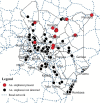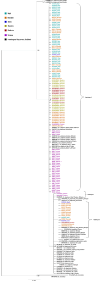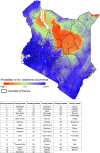Spatial distribution and population structure of the invasive Anopheles stephensi in Kenya from 2022 to 2024
- PMID: 40481090
- PMCID: PMC12144165
- DOI: 10.1038/s41598-025-04682-1
Spatial distribution and population structure of the invasive Anopheles stephensi in Kenya from 2022 to 2024
Abstract
This study analyzes the distribution, genetic diversity, and spread of Anopheles stephensi in Kenya following initial detection in December 2022. A total of 114 larval and 33 adult An. stephensi samples were confirmed in 7 of 18 surveyed counties majorly along transportation routes. Genetic analyses revealed three distinct genetic compositions with different levels of genetic diversity, suggesting multiple introductions into the country. The genetic composition of mosquitoes in most counties resembled southern Ethiopian populations, while those from Turkana showed a unique haplotype. A species distribution model predicts a more extensive range than currently observed, with low precipitation and minimal seasonal temperature variations as key factors influencing distribution. Challenges in adult sampling were noted, with larval sampling revealing co-occurrence with native Anopheles species. The findings have implications for surveillance and control strategies, emphasizing the need for continued monitoring, refined sampling techniques to inform bionomics, and cross-border collaboration.
Keywords: Anopheles stephensi; Kenya; Population structure; Spatial distribution.
© 2025. The Author(s).
Conflict of interest statement
Declarations. Competing interests: The authors declare no competing interests. Ethical approval: The methods used in this study were conducted according to the study protocol reviewed and approved by the Scientific and Ethics Review Unit (SERU) at the Kenya Medical Research Institute, SERU 2776. All methods were carried out in accordance with relevant guidelines and regulations. Informed consent from all subjects was obtained for both participation and publication of identifying information/images in an online open-access publication. Consent for publication: This manuscript is published with the permission of the Director-General of the Kenya Medical Research Institute.
Figures








References
-
- Carter, T. E. et al. First detection of Anopheles stephensi Liston, 1901 (Diptera: culicidae) in Ethiopia using molecular and morphological approaches. Acta Trop.188, 180–186. 10.1016/j.actatropica.2018.09.001 (2018). - PubMed
-
- WHO. World Malaria Report 2023. (World Health Organization, Geneva, Switzerland, 2023).
-
- Faulde, M. K., Rueda, L. M. & Khaireh, B. A. First record of the Asian malaria vector Anopheles stephensi and its possible role in the resurgence of malaria in Djibouti, Horn of Africa. Acta Trop.139, 39–43. 10.1016/j.actatropica.2014.06.016 (2014). - PubMed
-
- Seyfarth, M., Khaireh, B. A., Abdi, A. A., Bouh, S. M. & Faulde, M. K. Five years following first detection of Anopheles stephensi (Diptera: Culicidae) in Djibouti, Horn of Africa: Populations established-malaria emerging. Parasitol. Res.118, 725–732. 10.1007/s00436-019-06213-0 (2019). - PubMed
MeSH terms
Grants and funding
LinkOut - more resources
Full Text Sources

